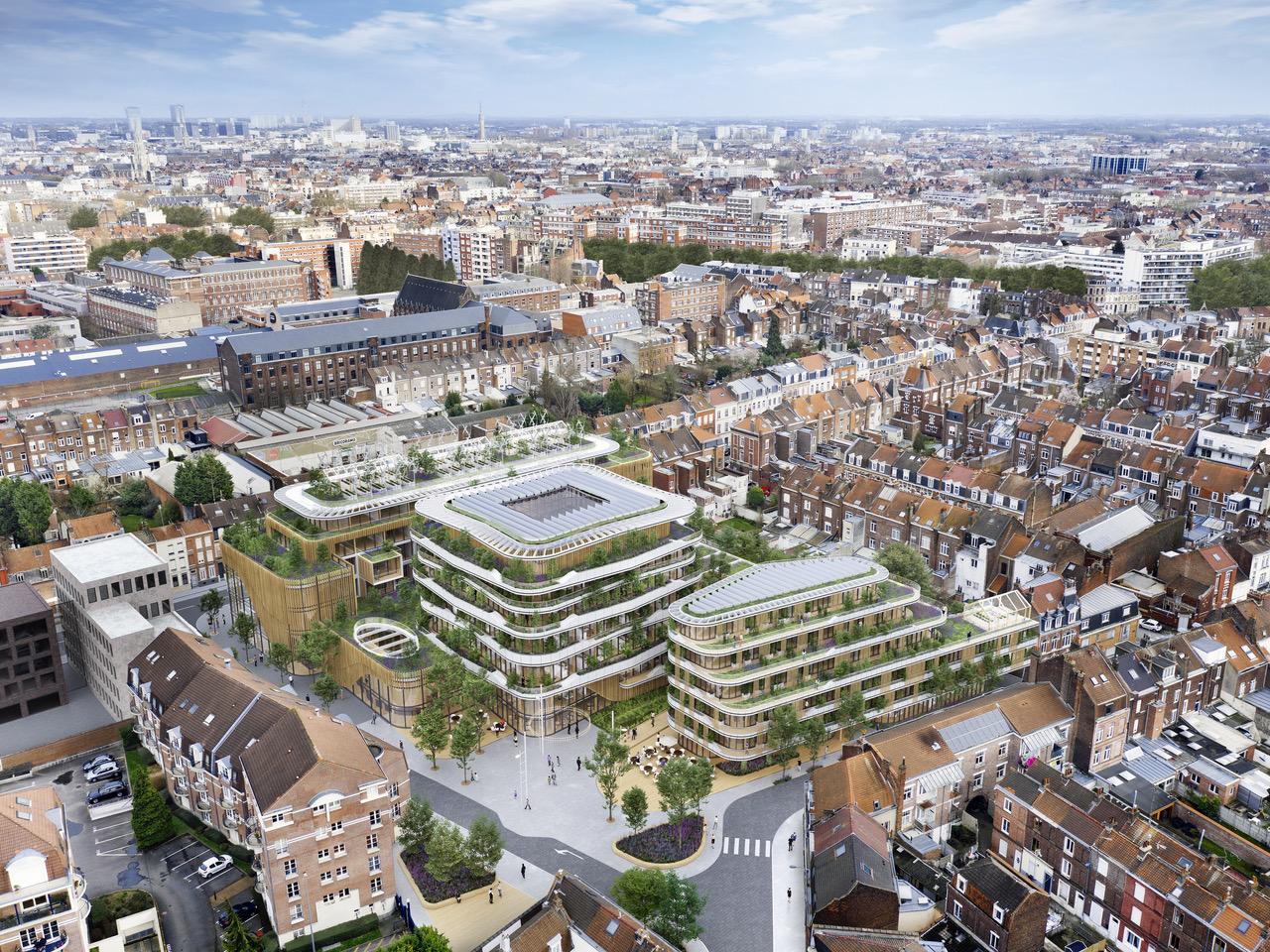
‘Archiborescence’ is a neologism, a combination of the words Architecture and Arborescence. It expresses Vincent Callebaut Architectures’ architectural leitmotif: ‘Transforming the city into an ecosystem, neighborhoods into forests and buildings into inhabited trees’.
In the heart of Lille, the project is inspired by the local biomimetic heritage called ‘Les Anciens Marais Vauban-Esquermes’ [The Ancient Marshes of Vauban-Esquermes]. This ecosystem produced its own energy by photosynthesis, emitted no pollution, and transformed all its waste into resources thanks to ‘virtuous circles’, all in a short circuit.
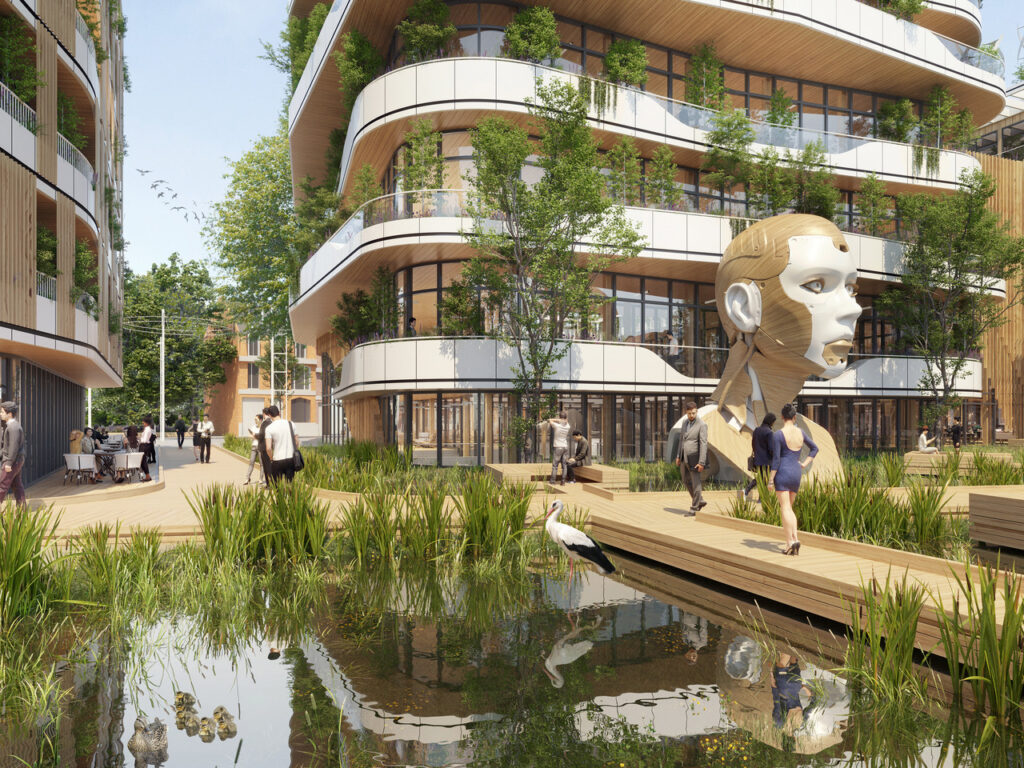
Instead of these old marshes, our urban intention is clearly to build a district in solid wood with a strong vegetal and aquatic character, reflecting the collective memory of the ecosystem, which has always enjoyed positive biodiversity. Our desire is to offer Lille a double green and blue landmark in the urban framework, at the intersection of the Vauban and Esquermes districts, between the Deûle River, the Universities, and the City Center.
Thanks to the Dynamic Thermal Simulation (DTS), the performance of the bio-based materials implemented, as well as the bioclimatic design choices and the integration of renewable energies; for the first time in the European Metropolis of Lille, we are aiming to achieve a building which may obtain the E4 level of the E+C label.

Concretely, Vincent Callebaut Architectures want the project to have a neutral carbon footprint and produce more energy than it consumes on a regular basis, even during phases of low renewable energy production. In addition, we plan to develop low technology for exchanging energy flow between offices and homes. As demonstrated by the DTS carried out in the upstream phase, the energy needs of these two programs make it possible to cover the needs over the entire typical day; the energy accumulated in offices at the end of the day being recycled during the night in residences.
As working towards a collective commitment to co-build a low-carbon city certified by the E+C label (level E4), the 5 pillars of the ‘Archiborescence’ project are as follows:
PILLAR 1: A PERMEABLE URBAN DESIGN TO MAKE THE DISTRICT ACCESSIBLE TO EVERYONE AND TRANSFORM IT INTO A DESTINATION
Before any architectural project commences, there is an urban challenge for residents. That of the Michel Servet site is twofold: to create a new urban space and energize the heart of the location by making it accessible to all.
First of all, at the Servet-Canteleu corner, the aim is to create a new generous and welcoming urban place in order to energize the district and articulate the flows that cross it. Vincent Callebaut Architectures designed this square, ideally south-west facing, to be as wide as possible, from facade to facade, eliminating the roundabout to increase the pedestrian walkways. The Jardins de Turenne square is also perfectly integrated into the design of the new square in order to unify them.
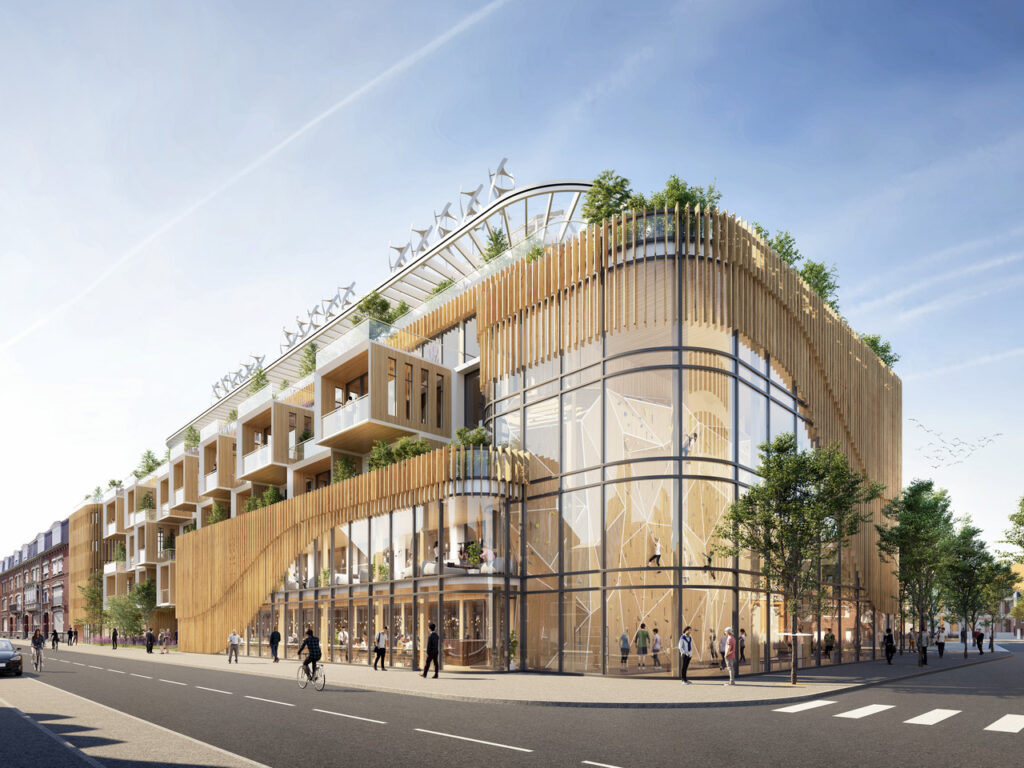
Then, the architect is interested in the concept of creating free and open heart within the block, where a green ‘trail of breadcrumbs’ weaves across the site from la Communauté des Filles de la Charité, la Cité Fauchille and the Rue Bailleux Square. The site being historically located along the Old Vauban-Esquermes Marshes (with fine winding canals in former times), it seemed opportune to reinterpret this ‘Genius Loci’ through a landscaped allegory proposing a garden crossed by small canals collecting rainwater and connecting the new square in the heart of the block. Between these canals, we will plant a range of riparian species to evoke a little more the ancient shores of the Marais d’Esquermes.
A haven of water and greenery, the heart of the block becomes a true ode to biodiversity where it is ideal to live, have fun, and meet your neighbors in a friendly atmosphere. It is accessible to all with special attention to people with disabilities. The space will be open to the public during the day, and then secured at night by a system of gates managed by a management service. A 12-meter-wide (39 ft) full-height path connects this natural setting with the new Servet/Canteleu square.
The streets, public square, and courtyard garden within the heart of the block are therefore connected by visual openings under high porches from rue de Turenne, the future Place, and rue Canteleu ensuring that the site is traversable for residents and users.
The architectural design also proposes the expansion of the perimeter walkways in rue de Turenne, rue Michel Servet, and rue de Canteleu. The facades are either installed so as to recreate the urban alignments or are set back to save all the existing large trees that border the site.
On Rue de Turenne for example, the facade of the rehabilitated stand is revived by a set of bow windows exploiting the potential offered by the removal of the existing building.
PILLAR 2: MULTIFUNCTIONAL PROGRAMMING LED BY ARCHITECTURAL ENTITIES WITH DISTINCT IDENTITIES AND HIGH-QUALITY PRACTICES
The permanent concern of the BECI Group is to develop a very rich multifunctional program in order to ensure a coherent and balanced social mix for the life of the district. The architectural challenge is to translate this programmatic richness into distinct functional entities that are perfectly connected and working together with each other. The prescriptions of the PLU (Local Urban Planning Plan) have therefore been applied to reflect this functional density with the most generous ceiling heights possible and various sizing templates.
The user is at the heart of the design of this urban complex. In this sense, the accommodation has dual orientation, comfortable surfaces, and large intimate outdoor spaces. The eco-design of the buildings optimizes acoustic comfort and air quality, and their design limits operating and co-ownership costs.

The use of alternative transport is facilitated and encouraged. The car parks created encourage co-sharing and electromobility via information and communication technologies. The project integrates high-quality two-wheeled parking spaces with intentional design. They are secure, comfortable (including for transport bikes), and equipped with maintenance services (repair/maintenance workshop, individual storage lockers for equipment, etc.).
The mixed program offers multiple housing opportunities (private home ownership, social rental opportunities, social sustainable home ownership, hotel opportunities) associated with a tertiary university residential opportunity. The whole benefits from sports areas (fitness room, dance/yoga/pilates room, climbing area) and services (shops and professional services) that are open to all.
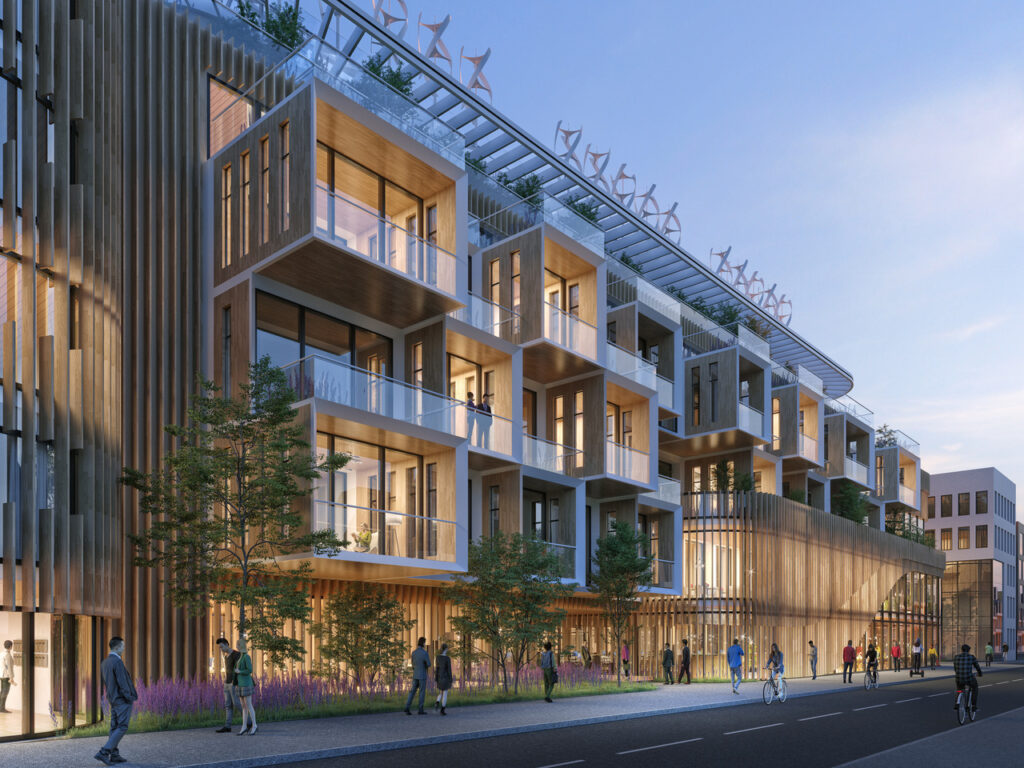
The use of alternative transport is facilitated and encouraged. The car parks created encourage co-sharing and electromobility via information and communication technologies. The project integrates high-quality two-wheeled parking spaces with intentional design. They are secure, comfortable (including for transport bikes), and equipped with maintenance services (repair/maintenance workshop, individual storage lockers for equipment, etc.).
The mixed program offers multiple housing opportunities (private home ownership, social rental opportunities, social sustainable home ownership, hotel opportunities) associated with a tertiary university residential opportunity. The whole benefits from sports areas (fitness room, dance/yoga/pilates room, climbing area) and services (shops and professional services) that are open to all.
Built from trees cut and harvested nearby, within the Lille region, in the heart of eco-responsible forests – where each cut tree equates to a replanted tree – the ‘Archiborescence’ project will therefore be a real carbon sequestration well. In fact, when trees grow with natural photosynthesis, the stored carbon is ‘trapped’ in solid wood and is not released into the atmosphere. For 1 ton of wood produced, about 0.9 tons of carbon is confined.
This means we are talking about a building with a negative carbon footprint! In addition, the project advocatesthe use of bio-based materials for facades, insulation (interior and exterior), and interior fittings (50% of materials will be labeled C2C) as well as an ‘Upcycling’ approach which is implemented in demolished buildings to strive for the zero-waste objective
.
PILLAR 4: ARBORESCENT ARCHITECTURE, AN ODE TO BIODIVERSITY (Biodiversity Label)
The metamorphosis project is organized around the heart of the city block where it is most densely vegetated in the open ground. This basic principle is combined with the various techniques of vegetating the building (intensive, semi-intensive, extensive). These are deployed throughout the program on balconies, roofs, and patios. This intensive revegetation has the following objectives:
– The creation of a refreshing urban island
– The repatriation of biodiversity in the heart of the city
– Tainwater recovery, and its phyto-purification (100% Water Footprint approach)
– The development of Urban Agriculture and co-gardening in permaculture

Urban farms have been created on the roof of the former high school’s existing stand with, in particular, over an area of 300m² (3229 sq. ft), a collective approach in neighborhood networks (promoting social inclusion and intergenerational solidarity). This mode of operation makes it possible to complete the professional production system which will also be installed on this roof. The area dedicated to establishing this professional partner is 500 m² (5382 sq. ft), which will benefit from a profitable business model producing 25 kilos of fruit and vegetables per m² (55 lbs. per 10 sq. ft) per year. Wildlife lodges, insect and bat hotels, as well as nesting boxes are integrated into the project to strengthen the ecological corridor.
In terms of water management, all stormwater buffering is done within the plot itself. Roof storage areas provide gravity watering (via rain chains) to landscaped facades and balconies. The central marsh optimizes the infiltration and recovery of rainwater. It is designed in such a way as to avoid any stagnant water and to ensure autonomous management and maintenance. Rainwater is reused for watering all the green spaces and to supply the toilets of tertiary programs.
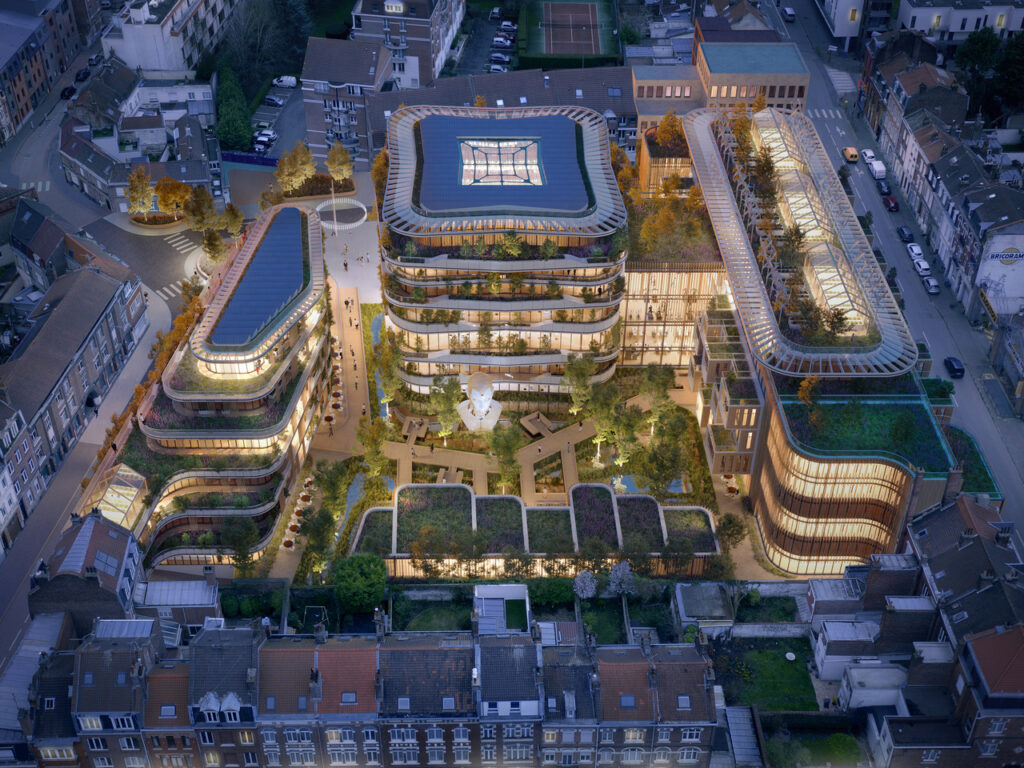
PILLAR 5: PASSIVE BUILDINGS ALLIED WITH RENEWABLE ENERGIES TARGETING THE OBJECTIVES OF RE 2020 (ENERGY SELF-SUFFICIENCY)
After choosing solid wood construction to drastically reduce the carbon footprint of the project during its construction/renovation, our efforts have focused on the integration of passive systems and renewable energies to reduce its carbon footprint during its operation.
First of all, all buildings benefit from double insulation – interior and exterior – from natural materials such as straw, hemp, and cellulose wadding. In addition, green roofs and balconies make it possible to control solar power generated and take advantage of the evapotranspiration of plants to cool the apparent temperature by 2 to 5 degrees Celsius.
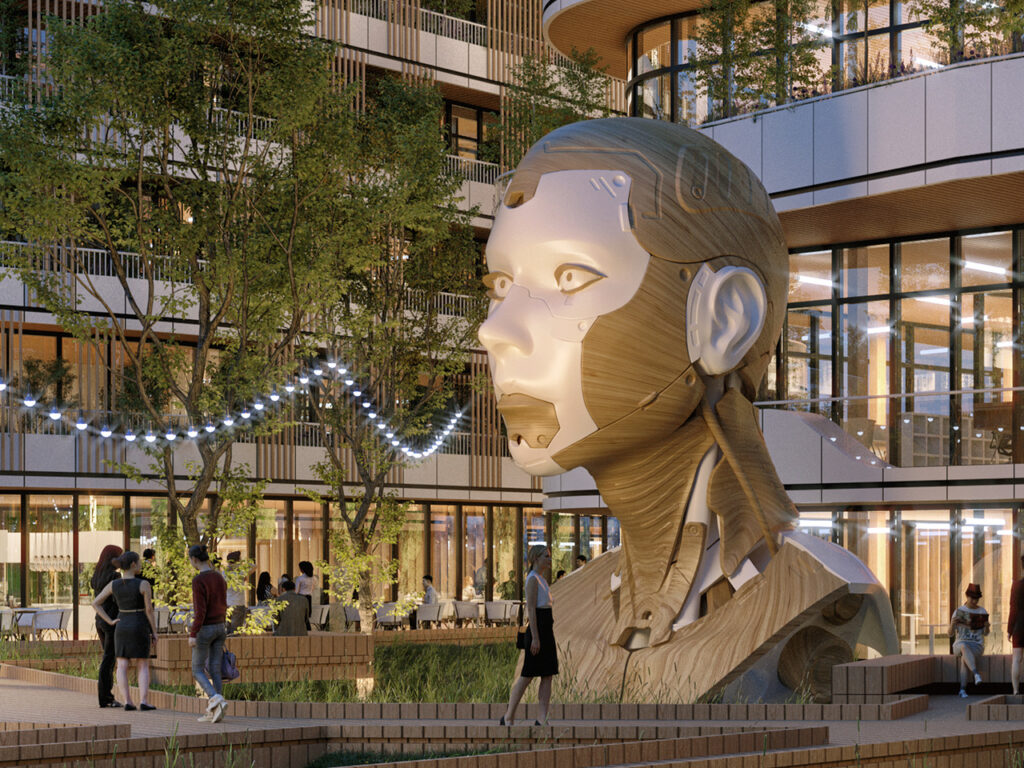
To ensure natural ventilation in each apartment, wind chimneys cross the vertical circulation cores throughout their entire height. These chimneys suck in the air that passes under the foundations where the thermal inertia of the earth is constant all year round at 18 degrees Celsius (64° F). This naturally seasonally conditioned air is then forced into the apartments like in a termite mound. The curved facades also favor air circulation and the dispersion of pollutants.
On the roofs of office and residential buildings, solar photovoltaic and thermal canopies produce electricity stored in hydrogen cells for auto-consumption, and domestic hot water redistributed in a virtuous cycle in bathrooms and kitchens. To top it off, a farm of 30 magnetic levitation axial wind turbines also generates electricity in situ without any noise pollution on the roof of the co-living residence.
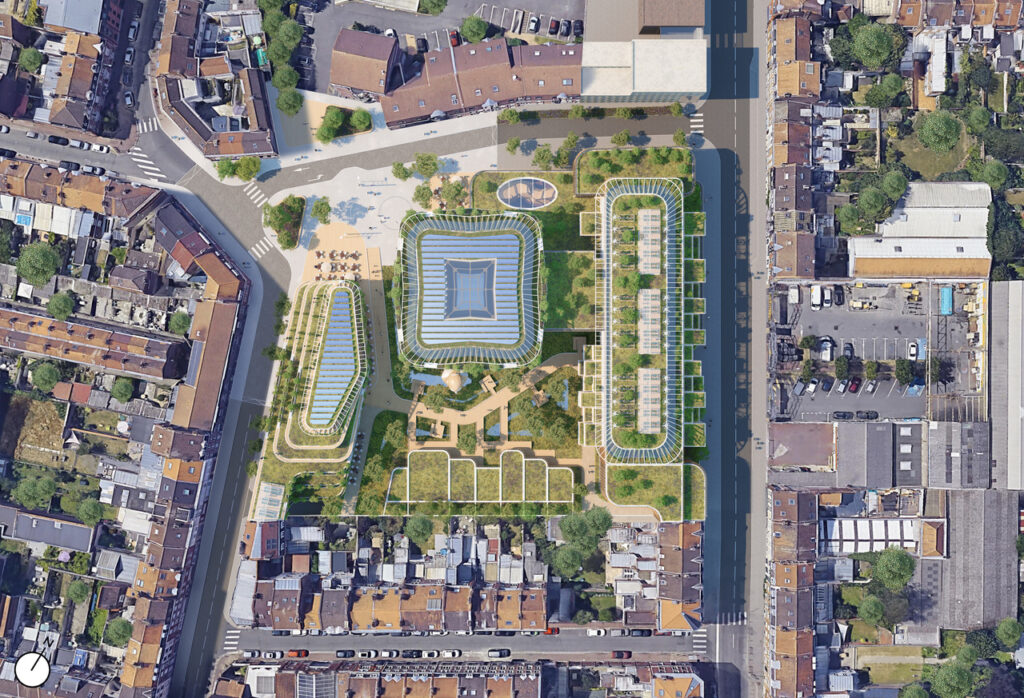
In the heart of Lille, the ‘Archiborescence’ project advocates the reconciliation of the City and the Countryside through timber, elegant, and frugal architecture. It is now a question of producing as close as possible to the consumers and building with the minimum of resources in order to reduce our greenhouse gas emissions. As part of the new circular ‘regenerative’ economy, the renovation of this riparian district – built, clad and insulated with wood – is a prototype of resilient and agile town planning respecting the four pillars of the ecological city of the future, namely: energy self-sufficiency (heat, refrigeration, and electricity); revegetation of buildings and the development of urban agriculture; alternative soft transport focused on pedestrian and two-wheel traffic; social inclusion through flexible spaces with high use opportunities, and shared between inhabitants and solidarity services.
Vincent Callebaut Architectures